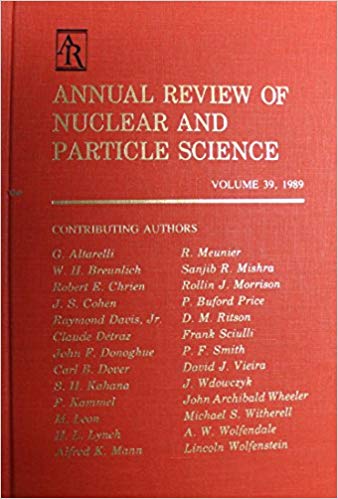对撞机中的双轻子作为夸克-胶子等离子体的探测器
IF 8.4
2区 物理与天体物理
Q1 PHYSICS, NUCLEAR
Annual Review of Nuclear and Particle Science
Pub Date : 2025-09-22
DOI:10.1146/annurev-nucl-121423-100858
引用次数: 0
摘要
超相对论性重离子碰撞被用来创造夸克和胶子的定义状态,即夸克-胶子等离子体(QGP),类似于早期宇宙中的物质。双轻子是QGP的独特探针。它们在碰撞的所有阶段都被发射出来,没有与周围物质发生强烈的相互作用,因此它们携带着关于介质演化的未被扭曲的信息。轻子-反轻子对的质量提供了一种独特的方法来分离部分子辐射和强子辐射。因此,双轻子可以用来研究QGP的平衡时间、平均温度以及通过矢量介子衰变在热介质中恢复手性对称性的相关效应。这个信息不能用强子获取。要付出的代价是普通强子衰变的大背景。我们总结了双轻子测量的潜力,迄今为止在对撞机上获得的结果,以及正在进行的关于进一步提高灵敏度的未来实验的努力。本文章由计算机程序翻译,如有差异,请以英文原文为准。
Dileptons at Colliders as Probes of the Quark–Gluon Plasma
Ultrarelativistic heavy-ion collisions are used to create a deconfined state of quarks and gluons, the quark–gluon plasma (QGP), similar to the matter in the early Universe. Dileptons are a unique probe of the QGP. Being emitted during all stages of the collision without interacting strongly with the surrounding matter, they carry undistorted information about the medium evolution. The mass of the lepton–antilepton pair gives a unique means to separate partonic from hadronic radiation. Thus, dileptons can be used to study the QGP equilibration time, its average temperature, and effects related to the restoration of chiral symmetry in the hot medium via vector meson decays. This information is not accessible with hadrons. The price to pay is a large background from ordinary hadron decays. We summarize the potential of dilepton measurements, the results obtained so far at colliders, and the ongoing efforts regarding future experiments with further increased sensitivity.
求助全文
通过发布文献求助,成功后即可免费获取论文全文。
去求助
来源期刊
CiteScore
21.50
自引率
0.80%
发文量
18
期刊介绍:
The Annual Review of Nuclear and Particle Science is a publication that has been available since 1952. It focuses on various aspects of nuclear and particle science, including both theoretical and experimental developments. The journal covers topics such as nuclear structure, heavy ion interactions, oscillations observed in solar and atmospheric neutrinos, the physics of heavy quarks, the impact of particle and nuclear physics on astroparticle physics, and recent advancements in accelerator design and instrumentation.
One significant recent change in the journal is the conversion of its current volume from gated to open access. This conversion was made possible through Annual Reviews' Subscribe to Open program. As a result, all articles published in the current volume are now freely available to the public under a CC BY license. This change allows for greater accessibility and dissemination of research in the field of nuclear and particle science.

 求助内容:
求助内容: 应助结果提醒方式:
应助结果提醒方式:


